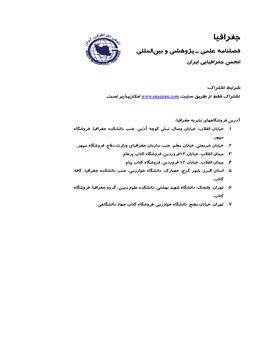Investigating the geographic distribution of Iran’s nationalities and its rule on future changes
Subject Areas :
1 -
Keywords: ethnicity, border areas, future developments. MADM.,
Abstract :
The Ideal thing to each national government is its nation enjoyment that is integrated among its members, significant differences linguistic, religious, ethnic and racial there and everyone belongs to a comprehensive national identity remember. Therefore, this study aimed to investigate the geographical distribution Ethnicity of Iran and its role in the future development of the country that the descriptive - analytical and field studies in this area have been used. First the index of mining and adherence to their national unity and solidarity among nations of Iran border have been investigated which the index is used in the field of seven. The findings obtained from MADM methods and analytical models SAR shows that among people living in border Lor by a factor of 0.67, the highest level of commitment and people Kurdish and Baluchi coefficient of 1.240.6 and 1.25, respectively, with the lowest level of compliance in cross-border inter-ethnic unity and integrity are indicators. Some centrifugal forces on the border of Baluchistan and Kurdistan are existed that somehow and in some cases have been proposed as potential hotbeds of crisis. Kurds and the Baluch of Pakistan in Iraq can be considered as hotbeds of tension and crisis which caused the formation of future developments in the aforementioned boundaries.
1. ابوطالبی، علی (1378)، حقوق اقلیت¬ها و همگرایی، ترجمه علی کریمی، فصلنامه مطالعات ملی، شماره 32؛
2. احمدی¬پور، زهرا؛ طهمورث حیدری، طیبه حیدری (1389)، تحلیل قومیت و همویت قومی در ایران، جهت امنیت پایدار، فصلنامه انتظام اجتماع، سال دوم، شماره اول؛
3. ایوبی، حجت¬اله (1377)، «شکافهای قومی و خشونت در پیکارهای سیاسی»، فصلنامه مطالعات راهبردی، پیش شماره اول؛
4. پورطاهری، مهدی(1389)، کاربرد روش¬های تصمیم¬گیری چندشاخصه در جغرافیا،انتشارات سمت؛
5. جلائی¬پور، حمیدرضا؛ کردستان (1372)؛ علل تداوم بحران آن پس از انقلاب اسلامی، تهران، موسسه چاپ و انتشارات وزارت امور خارجه؛
6. سید امامی، کاووس (1385)، قومیت از منظر سیاست¬های هویت، دو فصلنامه دانش سیاسی، شماره سوم، 1385؛
7. شیخاوندی، داور (1369)؛ زایش و خیزش ملت، تهران، انتشارات ققنوس؛
8. صالحی، امیری؛ سیدرضا (1385)، مدیریت منازعات قومی در ایران، تهران، انتشارات مرکز تحقیقات استراتژیک مجمع تشخیص مصلحت نظام؛
9. طباطبایی، سیدجواد (1380)، دیباچه¬ای بر نظریه انحطاط ایران، تهران، نگاه معاصر؛
10. فولر، گراهام (1372)، قبله عالم، ترجمه عباس مخبر، تهران، نشر مرکز؛
11. قوشچی رضاپور، محمد (1393)، جهانی شدن و تکثرگرایی قومی در ایران، چالش¬ها و فرصتها، فصلنامه مطالعات راهبردی و جهانی شدن، سال پنجم، شماره 14؛
12. مقصودی، مجتبی (1376)، ناهمگونی جمعیتی و توسعه ملی در ایران با تأکید بر ناهمگونی قومی، تهران، نشر موسسه مطالعات ملی؛
13. مومنی، منصور، (1382)، انتخاب روش بهینه انتقال آب به مزارع نیشکر در استان خوزستان، مجله مدرس، دوره 7، شماره 3.


